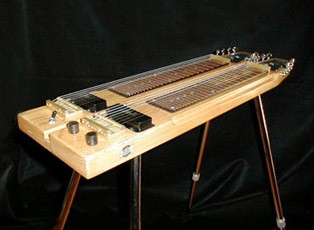
From the Wikipedia entries for Steel Guitar and Lap Steel Guitar:
Steel guitar refers to a method of playing on a guitar held horizontally, with the strings uppermost and the bass strings towards the player, and using a type of slide called a steel above the fingerboard rather than fretting the strings with the fingers. This may be done with any guitar, but is most common on instruments designed and produced for this style of playing.
The technique was invented and popularized in Hawaii, thus the lap steel guitar is sometimes known as the Hawaiian guitar, particularly in documents from the early 1900s, and today any steel guitar is frequently called a Hawaiian steel guitar. However in Hawaiian music, Hawaiian guitar means slack string guitar, played in the conventional or Spanish position.
Steel guitar technique also developed from bottleneck guitar, which is a similar technique to steel guitar but with the guitar held in the conventional position, and using a different form of slide to accommodate this playing position.
It is widely reported that The lap steel guitar was invented by a man named Joseph Kekuku in 1885. It is said, at the age of 7, Joseph was walking along a railroad track and picked up a metal bolt, slid the metal along the strings of his guitar and was intrigued by the sound. From there he taught himself to play using this method with the back of a knife blade. Still various other people have been credited with the innovation. The instrument was hugely popular – a major fad – in the United States during the 1920s and 1930s. It was electrified in the early Thirties by Bob Dunn, a musician in Houston,Texas (who played in the Western swing band Milton Brown and His Musical Brownies; Dunn had his own self-named music store in the Houston area.) This made the so-called “Hawaiian” guitar the first electric instrument (just a few years before Les Paul and Charlie Christian modified their instruments).
The lap steel, dobro and pedal steel guitar are associated most closely with Hawaiian music, country music and bluegrass, though some players have used them in rock music, jazz, blues, and other musical genres. The round neck, metal-bodied resonator guitar, on the other hand, is used almost exclusively by blues, rock, or blues-rock musicians.
From the film The Little Giant (1933), featuring Edward G. Robinson.
The legendary Hawaiian guitar master Sol Hoopii provides the background steel guitar playing in these two Pre-Code scenes.
“Yodeling Boogie” (1950) by Wesley Tuttle.
The equally legendary Speedy West almost steals the show at 2:10. Notice the eye candy sitting and clapping along by Speedy’s feet.
[audio:Daniel_Lanois___JJ_Leaves_LA.mp3]
“JJ Leaves LA” (2003) by Daniel Lanois.
A complete change of pace from the breakdowns shown above, this sublime atmospheric number from Lanois’ thoroughly brilliant album Shine seems to point a futuristic direction for the lap steel guitar. Bruce Kaphan’s Slider album from 2000 took a similar approach to pedal steel playing, in the name of New Age Music (it is on the Hearts of Space record label).
An homage:
[audio:Ry_Cooder___Steel_Guitar_Heaven.mp3]
“Steel Guitar Heaven” (2008) by Ry Cooder


0 responses so far ↓
There are no comments yet...Kick things off by filling out the form below.
Leave a Comment